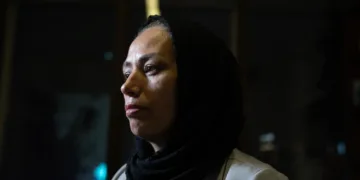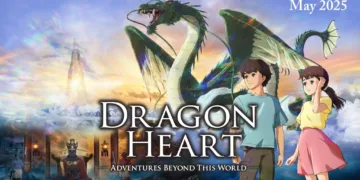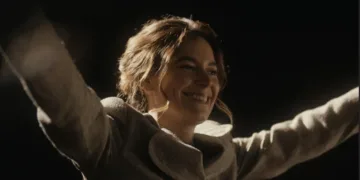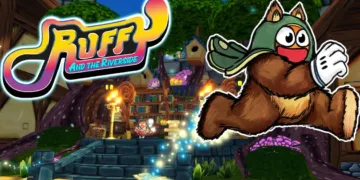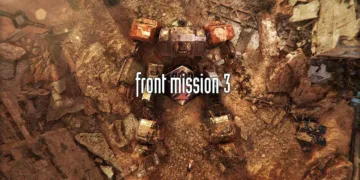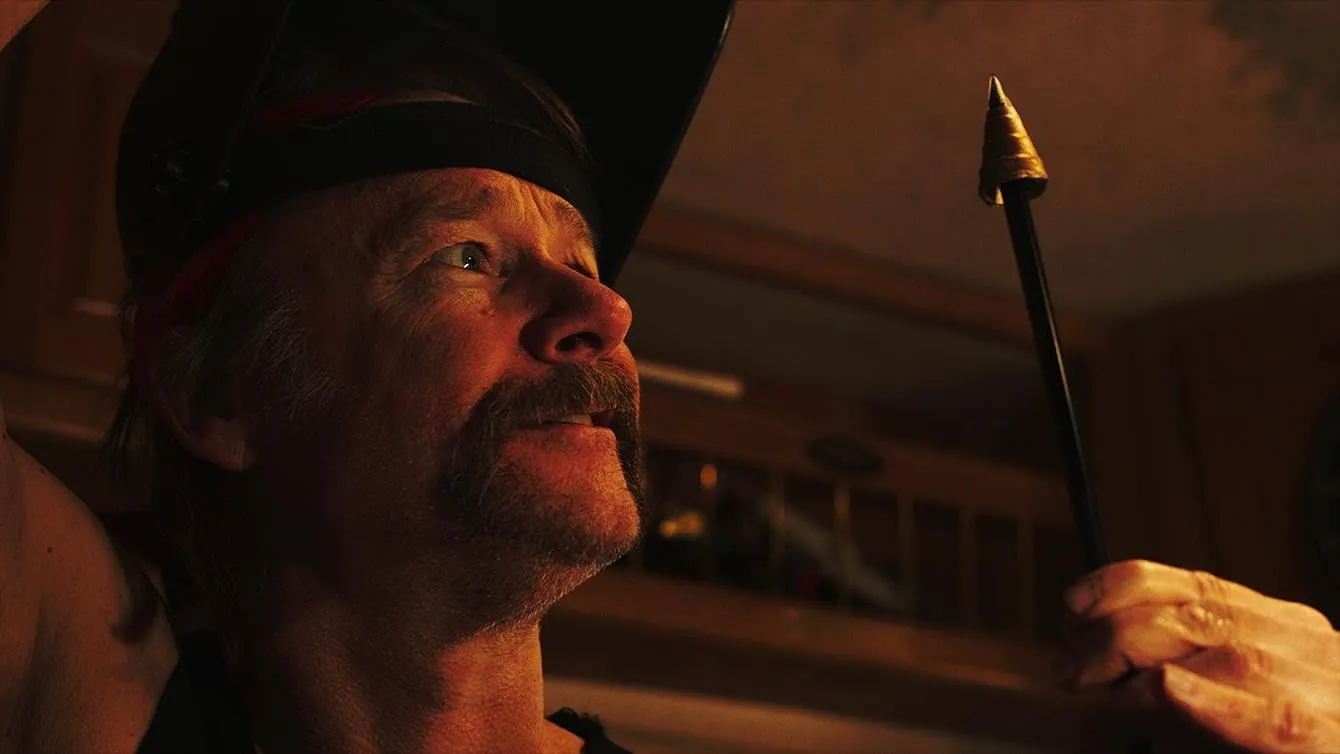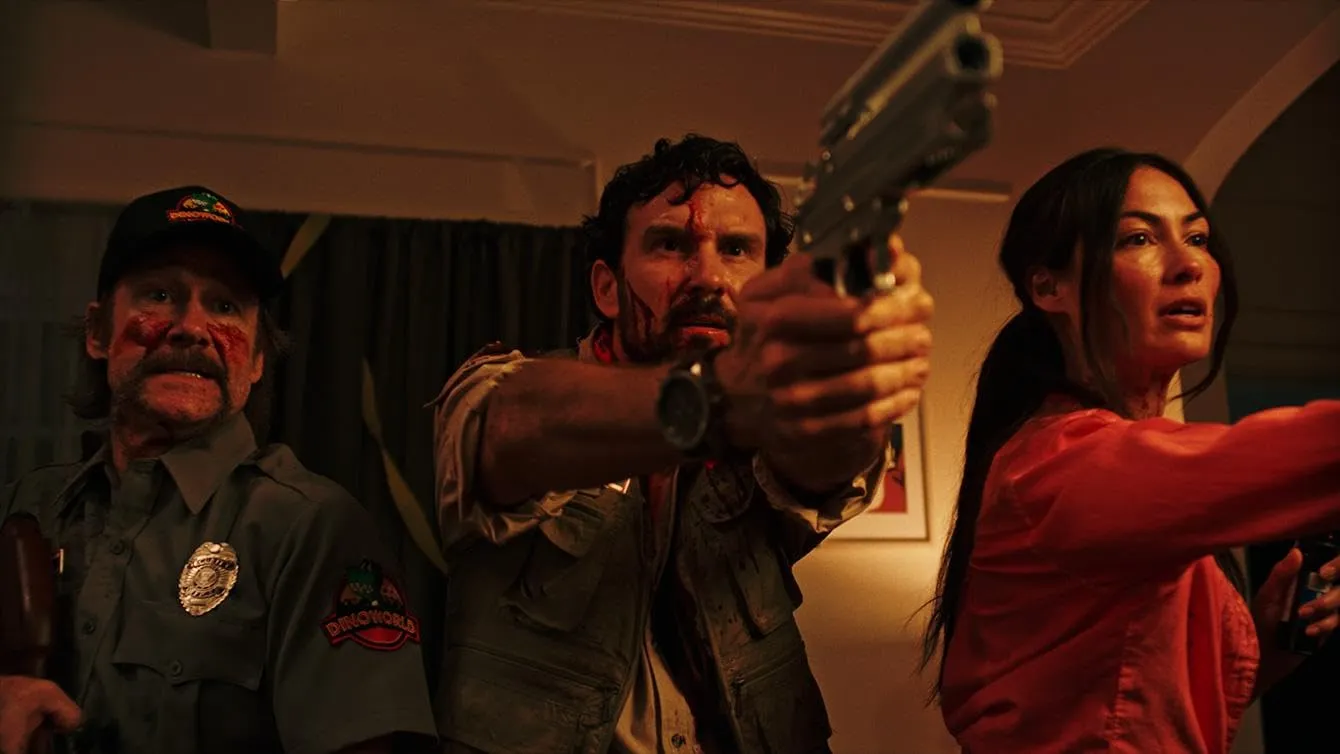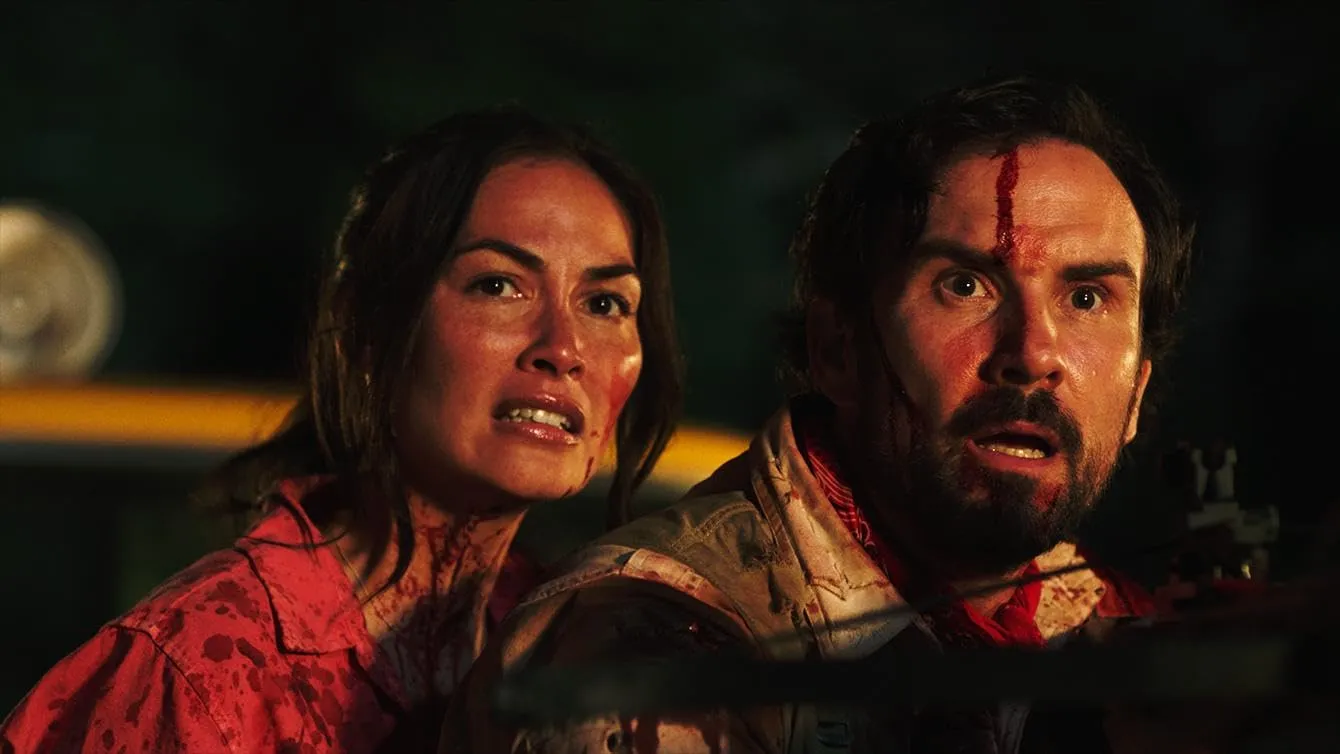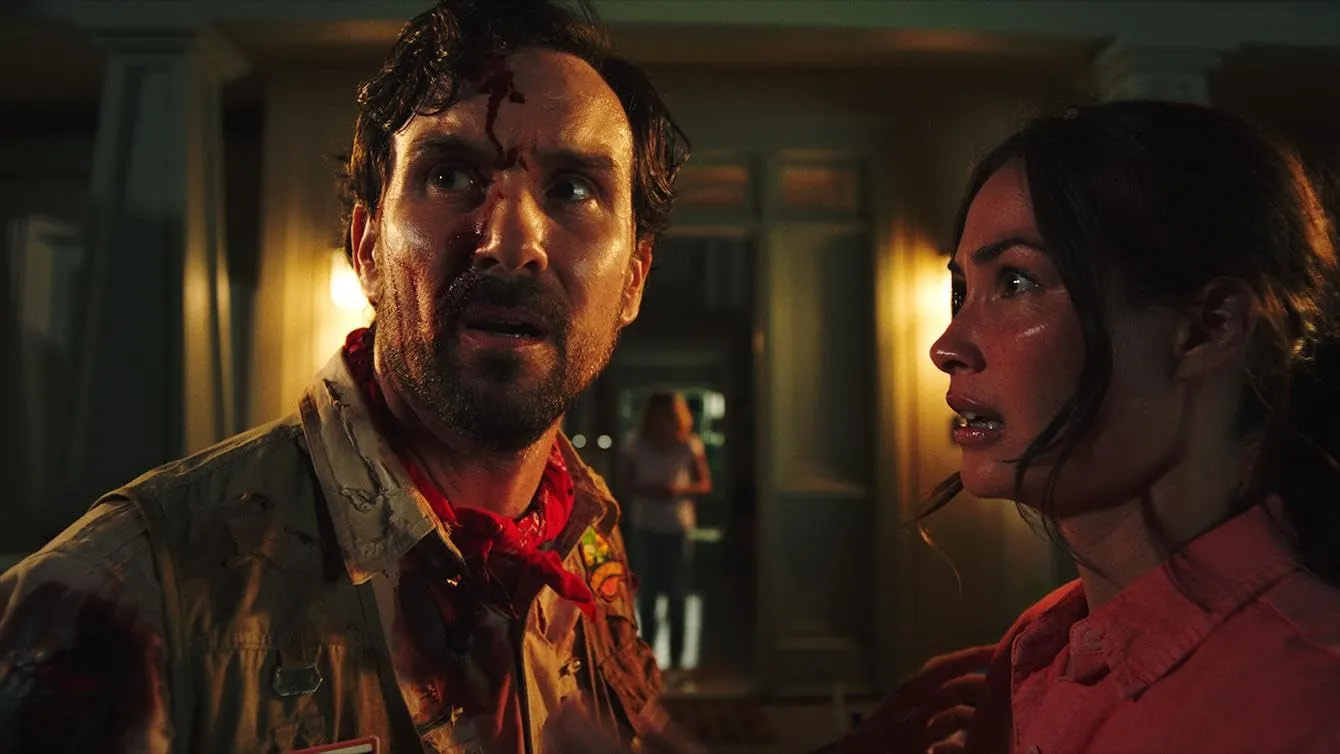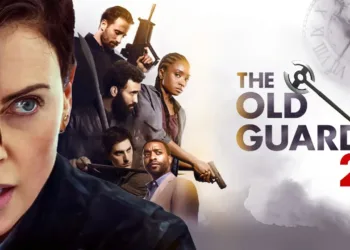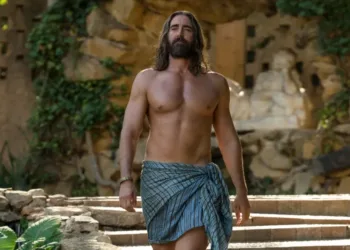The Invisible Raptor is a comical tale of scientific arrogance gone awry, centering on the escape of a genetically produced, invisible velociraptor from a corporate lab. This apex predator (essentially a violent metaphor for unrestrained ambition) quickly terrorizes a small village, leaving behind headless bodies, incomprehensible wreckage, and, yes, piles of visible dino-poo.
Enter Dr. Grant Walker, a paleontologist whose once-promising career has been relegated to dino-rapping for children at an amusement park, and his odd partner, Denny Danielson, a hapless security guard with more grit than intelligence. Together, they form the mismatched duo that feels straight out of a 90s buddy comedy, equipped only with their wits and a common desire to save their separate lives.
But behind the surface of this absurd premise sits a very complex concept: the invisible opponent. From a cinematic standpoint, creating a monster that cannot be seen (but whose impact is felt viscerally) is both a daring narrative technique and a logistical masterstroke. After all, visual absence creates a distinct kind of tension, one based on imagination rather than spectacle. The unseen raptor represents the unknown and unspoken traits that have tormented humans since immemorial.
However, there is a subtle observation here regarding the difficulties of an invisible opponent. How do you formalize an absence? How can you keep the audience’s interest when your titular monster is, by design, absent? Hermosa’s response is twofold. First, he embraces the absurdity, employing slapstick humor and creative environmental signals (floating balloons, shredded arms, and infrared reveals) to remind us that invisibility is both a narrative gift and a constraint.
Second, he redirects the narrative’s focus to the human characters, whose quirks, peculiarities, and outlandish actions fill the space left by the raptor. It’s a gamble, and while it occasionally pushes the boundaries of realism (a raptor opening doors with stolen eyeballs is both clever and ridiculous), it succeeds precisely because the film doesn’t take itself too seriously.
An invisible raptor is a contradictory creature defined by its absence, a predator whose greatest strength is erasure. If it isn’t a metaphor for modern fears—of surveillance, loss, and the unseen forces that shape our lives—I’m not sure what is.
Laughing in the Face of Death: The Tightrope of Horror-Comedy
Balancing humor and horror is an alchemical process that many films have attempted, but few have completely accomplished. With a swagger that feels purposeful and wonderfully anarchic, the Invisible Raptor treads this perilous tightrope. The film reveals its absurdity—an invisible velociraptor causing havoc while a discredited paleontologist and a dumb security guard struggle to stop it—.
Still, its success resides in leveraging this absurdity to create both cutting humor and visceral gore. One moment, you’re smiling at a helium balloon connected to the rampaging raptor like some macabre party treat. The next you’re groaning as the same unseen force rips an unfortunate victim limb from limb (real effects that are hysterically imaginative but weirdly effective).
This tonal balance is more than just a stylistic choice; it is an intentional appeal to a certain audience. After all, horror-comedy is a genre for people who like the absurdity of existence. It’s intended for viewers who can find catharsis in the grotesque and recognize that laughter and horror frequently coexist. (After all, what is humor but the unexpected disturbance of expectation, and what is horror but the same disruption without the punchline?)
However, the balance is not always perfect. Some jokes border on immature territory (the frequency of excrement gags, for example, feels like a wink to South Park fans), while others, like a raptor assaulting a gigantic chicken mascot, attain surreal brilliance. The unevenness is part of the charm. It mirrors the raptor’s unpredictable unpredictability—a creature representing the film’s dichotomy of dread and comedy.
But who exactly is this movie intended for? Certainly not the Spielberg purists who regard Jurassic Park as sacred literature (though they may reluctantly appreciate the film’s respectful Easter eggs). It is also unsuitable for individuals looking for polished thrills in premium horror.
No, The Invisible Raptor is aimed at the midnight movie crowd. These cult film fans cheer during decapitations and quote one-liners with delighted irreverence in their voice. It’s a love letter to VHS monster movies and self-aware, low-budget spoofs that survived in the shadow of Hollywood blockbusters.
In many ways, the film’s tone mirrors a larger cultural time. We live in an era of comedy and tragedy becoming increasingly blurred, and memes about existential dread coexist with sincere calls to action. The Invisible Raptor taps into this zeitgeist with a kind of wild abandon, reminding us that sometimes the best way to face our fears—be they invisible predators or the specter of society collapse—is to laugh in their faces—or, in this case, laughing while they rip someone’s face off.
Spielburgh County: A Cinematic Love Letter to Blockbuster Nostalgia
If imitation is the purest form of flattery, The Invisible Raptor could be Spielberg’s most devoted admirer. The film gleefully builds its identity on the cinematic skeleton of Jurassic Park, with allusions so obvious they border on irreverent parody—yet nonetheless stay appealing.
Dr. Grant Walker (his name is a combination of Jurassic Park’s Dr. Alan Grant and Spielbergian adventurers everywhere) is a paleontologist whose khakis and bleak optimism feel like a thrift-store tribute to Sam Neill. Meanwhile, the score flirts with John Williams’ renowned themes, bringing the grandeur of orchestral flourishes to scenes featuring balloon-chasing dinosaurs and poop-centric humor. It’s absurd, but that’s exactly the point: the film embraces Spielberg’s legacy with the kind of unselfconscious glee you’d expect from a dinosaur-obsessed youngster.
Beyond Jurassic Park, Easter eggs grow like genetically modified raptors in a badly managed laboratory. The boy named Elliot (a clear homage to E.T.) attracts the invisible predator with candy, creating a scene of youthful wonder—until that wonder turns into carnage.
The ending, with its helium balloon tracking mechanism, is a playful take on Jaws’ barrels. Even Sean Astin’s appearance as “Willie” is reminiscent of The Goonies (a Spielberg-produced classic), reminding us that this film thrives on the nostalgia economy, mining our collective pop-cultural memory for both humor and pathos.
But Spielberg isn’t the only cinematic deity mentioned here. The film frequently pulls from Predator’s visual language, particularly using infrared to expose the raptor’s movements. This brilliant twist underlines the predator/prey dynamic in a frightening and self-aware way. On the other hand, Sandy Martin’s grizzled chicken farmer feels like she walked in from an alternate-universe Coen Brothers film, offering a homespun roughness that balances the cartoonish turmoil elsewhere.
These references do more than just wink at the audience. They establish a shared cultural shorthand, transporting us to a world where the familiar is transformed into something deliciously absurd. It’s a cinematic collage, a mash-up of blockbuster DNA woven into a creature that, like its namesake raptor, is both fearsome and ridiculous.
But therein lies its charm: much like Spielberg’s work, the film recognizes that homage is more than just reproduction; it is also about transformation. The sacred becomes profane, the majestic becomes ridiculous, and the invisible predator mirrors our infatuation with the cinematic past.
Paleontology and Poop Jokes: The Odd Couple at the Heart of the Chaos
Dr. Grant Walker—whose very name is a wink to Spielberg fans—is one of the most unusual protagonists to grace a film about prehistoric murder machines. Grant, a former paleontologist, now spends his days rapping in a dinosaur costume for children at DinoWorld.
This theme park feels like a capitalist fever dream of instructional kitsch. His fall from grace—losing credit for his landmark discovery of a “dinosaur butthole” (yes, really) to a deceitful partner—is both absurd and strangely heartbreaking.
While overblown, this history speaks to bigger themes of professional disillusionment and the fragility of recognition in a world that frequently rewards opportunism over merit (a tale as ancient as Darwinism). Grant’s reasons are multifaceted: catching the invisible raptor isn’t just about survival; it’s a desperate attempt at redemption, a chance to restore his legacy by demonstrating his brilliance in the most absurd way conceivable.
If Grant represents the fallen intellectual, Denny Danielson is the ideal counterpoint: a loving fool whose loyalty and childish optimism conceal a life of crushing uncertainty. Denny’s past, which includes childhood bullying and emasculating humiliation, is used for both humor and pathos.
His employment as the park’s mascot/security guard is an exercise in contrast: he is completely unsuited for heroism, yet his steadfast faith in Grant (and, by implication, himself) makes him an important collaborator. Together, they form a kind of anti-Holmes-and-Watson dynamic in which stupidity and brilliance converge into something surprisingly powerful.
The chemistry between Mike Capes (Grant) and David Shackelford (Denny) drives the film. Capes imbues Grant with a contained desperation that feels just one bad day away from full Ryan Reynolds-style snark. At the same time, Shackelford’s Denny is a walking punchline factory, delivering one-liners ranging from groan-worthy to amusing. Their chemistry is the beating heart of The Invisible Raptor, grounding even the most absurd scenarios in genuine camaraderie.
The deep emotional depth woven into their exchanges lifts their relationship above just humorous banter. Denny’s unwavering faith in Grant is both amusing and tragic, especially as it becomes evident that Grant, despite his flaws, sees Denny as more than just comedic relief.
Their mutual reliance has a calm nobility to it, a recognition that their weaknesses make them stronger together—a notion that resonates far beyond the film’s absurd premise. In a world full of invisible predators (physical and figurative), perhaps all we need is someone to believe in us, even when we can’t see the way forward.
And what if the person is wearing a massive dinosaur suit? Even better.
The Art of the Unseen: Crafting Chaos Through Practicality and Absence
Depicting an invisible enemy presents a paradoxical problem by design. How do you show what isn’t there? The Invisible Raptor tackles this dilemma with a combination of practical cleverness and digital sleight of hand, resulting in a predator that is both missing and omnipresent.
The practical effects are joyfully over-the-top, focusing on tactile gore that feels like a love letter to 80s creature flicks. Severed limbs hover in mid-air before being swallowed, heads are ripped off with ludicrous recklessness, and, in one image destined for midnight-movie eternity, a helium balloon connected to the raptor floats through scenes of carnage like a horrific party decoration. The gore, while exaggerated, is executed with conviction, making it both scary and hilarious—a delicate balance that mirrors the film’s overall tone.
The digital effects, albeit sparingly used, have a startling charm. Infrared views of the raptor’s motions echo Predator, while contextual disruptions—doors opening, objects flying—help convey the illusion of a raging, unseen force. What’s striking is how the raptor’s absence becomes its distinguishing feature; its invisibility heightens the tension, forcing the audience to envision the horror rather than merely watch it.
The film’s production design combines Spielbergian nostalgia with low-budget brilliance from the past. The Tyler Corp lab, with its sterile whites and frightening flashing displays, sets the tone for the raptor’s escape, combining corporate banality with mad scientist emotions. DinoWorld, on the other hand, is a fabulously gaudy playground of dinosaur kitsch, with its over-saturated colors standing out against the blood-soaked carnage that unfolds.
Then there’s the chicken farm, presided over by the charmingly grizzled Henrietta McCluckskey, where the absurdity reaches a climax as the raptor wreaks havoc among clucking chickens and giant chicken mascots. Each set feels like a world, adding to the film’s patchwork charm and grounding its absurd premise in tactile, evocative settings.
Together, the practical effects and set designs form a visual language that is both chaotic and unified. The film aspires for impact, not accuracy. And, in a world dominated by polished CGI shows, its emphasis on the dirty, grotesque, and wonderfully absurd is refreshingly honest.
When Dinosaurs Drag: The Tempo of Absurdity in a Two-Hour Runtime
The Invisible Raptor, a film that thrives on absurdity, sometimes stumbles under the weight of its extravagance. The nearly two-hour length feels overkill for an idea that, although clever, is necessarily limited in scope.
The opening act moves quickly and engagingly, from the raptor’s escape to the introduction of our mismatched heroes, with the intensity one would anticipate from a spoof-leaning horror-comedy.
However, as the second and third acts go, the film begins to wander, burdened by many gags (some fantastic, some less so) and a penchant for digressions that dilute narrative momentum. The Denny history detour, for example, is occasionally humorous but feels like an overlong punchline to a joke we already know.
This is not to imply that the slower moments are without charm. The film’s ability to revel in its ridiculousness—whether through lengthy poop humor or painstakingly built Spielbergian homages—is one of its draws. But there’s a narrow line between enjoying the absurdity and overstaying your welcome. Trimming for about twenty minutes would have improved the pacing without compromising humor or heart.
Despite its length, the film’s anarchic charm has a lasting impact. Its tone shifts—from comedic gore to unexpectedly poignant character moments—ensure there’s always enough to keep people interested. The humor, while uneven, is frequently laugh-out-loud amusing, and the mere audacity of the notion lends it cult-classic status.
Rewatchability, however, is determined by your tolerance for excess. Fans of midnight movie fare will most likely return for the inventive set pieces and memorable one-liners. In contrast, others may find the disjointed pacing prohibitive to repeat viewings. Still, The Invisible Raptor’s capacity to shift between ridiculous and reverent without losing its character guarantees that it leaves an impression—albeit one that, like the dinosaur itself, isn’t necessarily obvious at first glance.
For the Love of Dinosaurs and the Absurd: Who Will See the Unseen?
The Invisible Raptor thrives on contrasts. It’s brilliant but infantile, chaotic yet precisely referential. It manages to strike a balance between comedic gore and emotional character interactions.
Its merits include an innovative premise, imaginative humor, and a genuine (if irreverent) love of Spielbergian movies. However, the film’s flaws, most notably its bloated runtime and irregular pacing, may strain the patience of viewers who are less attracted by its sillier tendencies.
This is a must-see for fans of horror comedies and cult films, or anyone who remembers the absurdity of Tremors and VelociPastor on VHS. Fans of Spielberg may find a perverse kind of joy in its sympathetic satire.
The Review
The Invisible Raptor
The Invisible Raptor is a joyfully absurd space horror comedy that harkens back to Spielbergian nostalgia while carving out its absurd space in the cult film canon. Its original premise, biting humor, and unexpectedly poignant character relationships offset its lengthy runtime and occasional flaws. It's a film that is equal parts homage and satire, inviting people to laugh at the silliness of invisible dinosaurs and, perhaps, life itself. Fans of movies, lowbrow humor, and midnight-movie pandemonium will find much to love. In contrast, others may be left scratching their heads.
PROS
- Clever and absurd concept of an invisible velociraptor.
- Strong chemistry between the lead actors, Mike Capes and David Shackelford.
- Hilarious homage to Spielberg’s classics like Jurassic Park, Jaws, and E.T.
- Inventive practical effects and visually creative gore sequences.
CONS
- Overlong runtime, with moments that drag, particularly in the second half.
- Uneven humor, with some jokes relying too heavily on juvenile gags.
- Limited rewatchability for audiences outside the cult-film or midnight-movie crowd.
- Pacing issues and occasional tonal whiplash.






















